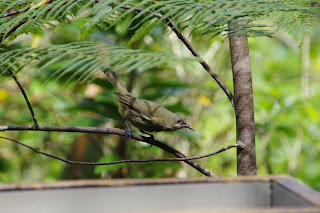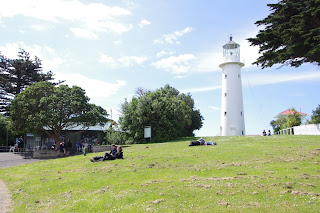 |
| Bell birds doing a little cooing |
When at the Broome Bird Observatory, we met one of the volunteers who leads guides on Tiritiri Matangi Island near Auckland. He gave us a brochure and said we would see birds there we could see nowhere else in New Zealand. Tiri (as the locals call it) is an “open reserve” which means it is a protected area that is open to anyone to visit any time. The only restrictions are that you must absolutely obey the rules designed to keep all invasive animals off the island and you are not allowed to camp or use a drone. We decided this was an opportunity we couldn’t pass up especially since the cost for the boat ride and a guided nature tour was only $50 each.
 |
| Bell bird at a feeder. They have sugar water available until the vegetation catches up. That could take years. |
 |
| Note the short tail. This is a North Island Robin |
 |
| Tuis are loud and aggressive. Other birds shy away. |
 |
| Note the white wattle hanging from its neck. |
In the 1860s the island was a sheep ranch. The first sheep rancher took the easy way of clearing the land by setting fires. In the following 120 years what the fires hadn’t destroyed was cleared leaving only about 6% of the land with native plants. When the ranching ended, people hoped it would revert to its original state, but the grasses grew so tall and thick that the trees had no chance of even beginning life. In 1984, a new plan was created and over the next decade volunteers got rid of the grasses and planted nearly 300,000 native trees. They also eradicated all the invasive animals including three species of rats, stoats, and skinks. The effort paid off. The forest have returned and the birds have been saved or reintroduced.
 |
| Stitchbird |
Among the birds and plants our guide introduced us to, he also showed us a small pipe used to show any rats or stoats who manage to arrive on the island. It is baited and has an ink pad. The rats leave their tracks behind alerting the managers that evil has arrived. Using dogs they run down the rat and kill it. John said the last one they had to find cost $15,000. Since one rat will destroy ten nests a night, speed is of the essence.
 |
| A rare Kokako You can hear them, but they tend to be in the brush. They don't fly well and really are not afraid of people so it can be easy to get close. |
We only had one day in Auckland so we missed opportunities to tour the city or take a wine tour as recommended by friends who visited here recently. We are glad we made this choice.
 |
| View of a volcano from Tiri. Auckland has several extinct volcanoes nearby. |
 |
| Auckland skyline |




No comments:
Post a Comment